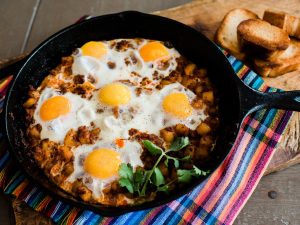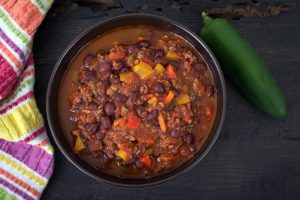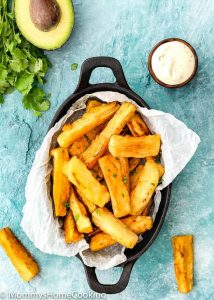The Complete Mexican South American and Caribbean Cookbook is a compilation-based cookbook centered around foods from South and Central American countries. It has a heavy emphasis on presenting the “true recipes” rather than the Americanized version of them and goes as far as listing the origins of some of the ingredients and preparation methods. However, the book does a rather poor job of explaining the cultural significance of some of these dishes and outright ignores the history behind them.

Rather than having the typical, single author, The Complete Mexican South American and Caribbean Cookbook enlisted the help of three authors to be constructed. Jane Milton, Marina Filippelli, and Jenni Fleetwood all added to the book, however, there is no indication of who wrote which section. All three authors are well versed within the cookbook and culinary industries, having had extensive careers in the culinary industry as well as having authored several other instructional cookbooks. Milton has even gone into business consulting, offering her 20+ years of restaurant experience to up-and-coming businesses that are looking to get on their feet. Milton also manages her own website where she helps provide consulting and culinary advice to other chefs, whose experience levels range from novice to expert (Milton).

The Complete Mexican South American and Caribbean Cookbook was published in January of 2007 by Barnes & Noble Incorporated. Over the years, it has had several other editions published, likely with better instruction and more recipes. Many of these versions were easily accessible on online retailers such as Amazon. To date, thousands of copies have been sold all around the globe, with many readers looking to take advantage of the recipes contained within.
The audience that The Complete Mexican South American and Caribbean Cookbook aims to reach is those interested in learning about culturally different foods. The book is geared towards anyone willing to learn and could be utilized by those with skill levels ranging from novice to expert. Conveniently, the book offers pictures to accompany the literature such that the audience can simply look at a photograph to confirm that they are preparing a dish properly. This is particularly helpful for those who are not well versed in cooking or are just beginning to learn how to cook. The cookbook also refrains from describing overly expensive meals, and typically stays in the lower end of the price range. However, some cuts of meat such as steak and tenderloins are utilized and may be a cost barrier to those with limited financial resources. This is not to say that the book does not offer plenty of alternative options, with chapters covering everything from appetizers to entrees, to desserts and drinks, with the main emphasis being on quick-to-prepare dishes that are delicious. Most platters can be prepared within an hour, which makes this a particularly appetizing book for those with little time. The contents of the book are relatively easy to follow based on chapter, however, the book is not laid out in any way. Rather, the novel follows a system that presents meals in the way in which diners would eat them, beginning with street food, appetizers, and entrees, and easing into specific types of meals such as beef, fish, poultry, etc. in later chapters. The book eventually tapers off with a drink menu and instructions on how to prepare traditional South and Central American beverages.

While this novel may excel in presenting a wide variety of dishes and drinks, it fails to acknowledge any historical or cultural background behind individual recipes. Furthermore, it fails to acknowledge anything regarding social classes, race, gender, rather, it simply addresses the dish and how to prepare it. This makes for a well orated book that is clear-cut and to the point. However, this is a good thing, since the title of the novel recognizes the origin of the food in-and-of-itself. Additionally, no particular attention seems to be paid to the rhetoric utilized throughout the book, however, special dietary considerations are made for those who are vegetarian which suggests that the authors did make small considerations.

Throughout the book, no acknowledgement is given to the origins of each recipe, rather, the book simply presents the origins of specific ingredients and spices in the introduction of the book. This fails to give the audience a true perspective on the origins of their meals and does not give proper credit to the founding chefs. Furthermore, no real attention is paid to the cultural significance of foods such as those served on El Día de Los Muertos which significantly takes away from the historical quality of the novel. Overall, The Complete Mexican South American and Caribbean Cookbook is not so complete after all and could use a few revisions to provide more cultural and historical context behind its recipes, however, the book does get its point across, having provided readers with hundreds of recipes to choose from to encompass all sorts of taste preferences.
References
Bauer, E. (2021, February 5). Mexican Tostada. Retrieved from https://www.simplyrecipes.com/recipes/mexican_tostada/
Filippelli, M., Fleetwood, J., Milton, J. (2007). The Complete Mexican South American and Caribbean Cookbook. New York, NY: Barnes and Noble, Incorporated.
Gavin, J. (2018, May 2). Chicken Enchiladas. Retrieved from https://www.jessicagavin.com/chicken-enchiladas/
Mexene (2020). Black Bean Chili. Retrieved from http://mexene.com/recipes/black-bean-chili
Milton, J (2017). Jane Milton Food Industry Expert. Retrieved from https://janemilton.com/
Nellie’s Free Range (2018). Baked Eggs with Chorizo and Potatoes. Retrieved from https://www.nelliesfreerange.com/egg-recipes/baked-eggs-with-chorizo-and-potatoes
Romero, O. (2019, April 10). How to Make Yuca Fries. Retrieved from https://mommyshomecooking.com/how-to-make-yucca-fries/